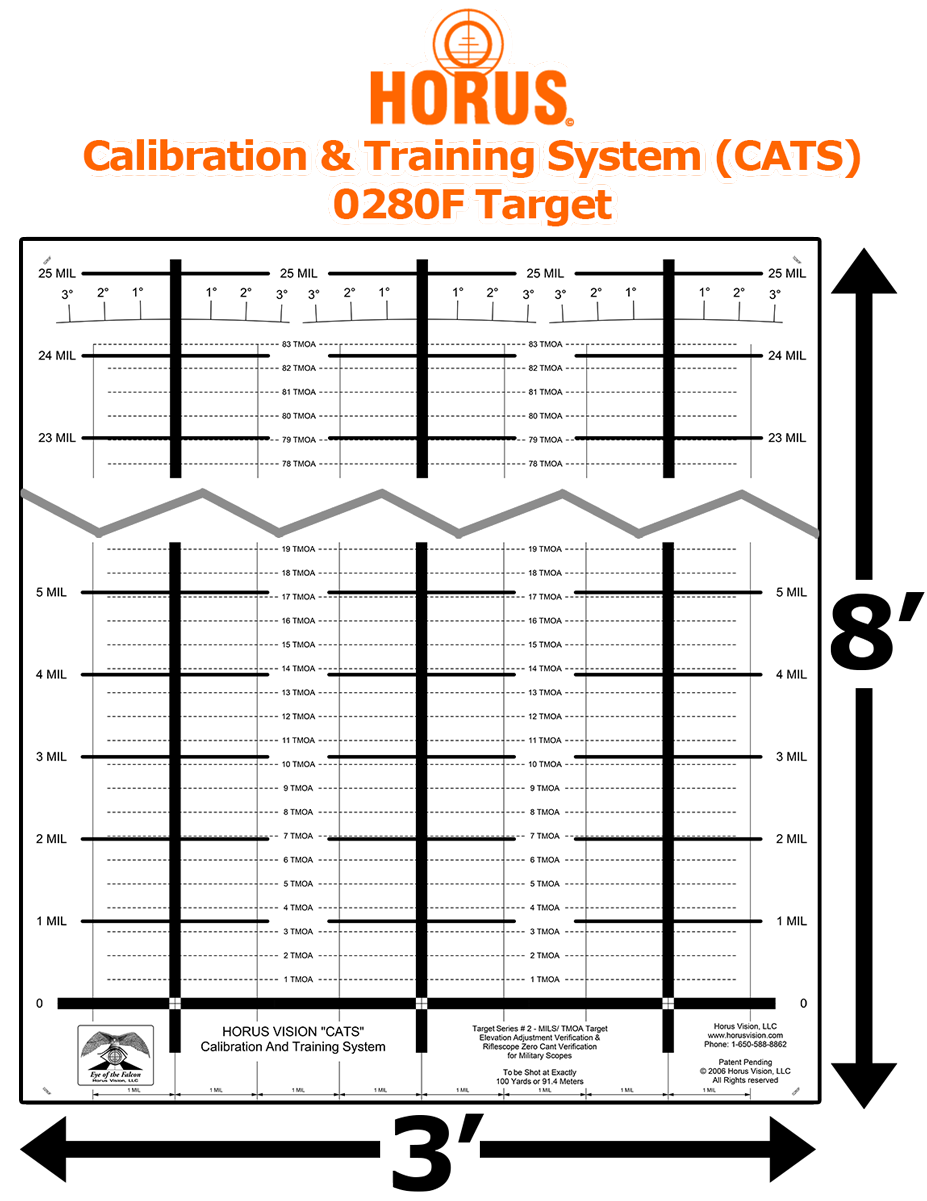I just want to know how accurate the claimed power numbers are, but I can’t think of a good way to easily check.
You are using an out of date browser. It may not display this or other websites correctly.
You should upgrade or use an alternative browser.
You should upgrade or use an alternative browser.
How do you verify magnification?
- Thread starter Sawney Bean
- Start date
Actual zoom I'm not sure but accuracy between the numbers is pretty straightforward. If something is exactly 1 mildot (or whatever marks the reticle has) at 4x and 4 mildots at 16x than the markings are at least close I would think. That works on a SFP but I've got nothing for checking an FFP
Upvote 0
I think that’s probably a really good indicator. If a mildot is a true milliradian at what is claimed to be 10x and at 16x is .625 milliradians then everything is likely accurate.
Of course the magnification could still be off, while the mildots are correctly spaced.
It’s just got me wondering given how things like lumens or milliamp hours are so often falsified, particularly on low end products. A budget scope maker could claim to be selling a 6-24x scope and actually be delivering a 7-14x scope and very few people would actually notice. I think that even most of us here would likely just call it a low quality scope, but wouldn’t likely realize how far off the magnification was.
Of course the magnification could still be off, while the mildots are correctly spaced.
It’s just got me wondering given how things like lumens or milliamp hours are so often falsified, particularly on low end products. A budget scope maker could claim to be selling a 6-24x scope and actually be delivering a 7-14x scope and very few people would actually notice. I think that even most of us here would likely just call it a low quality scope, but wouldn’t likely realize how far off the magnification was.
Upvote 0
You verify magnification by measuring something with your mildots at your reference magnification at a known range.
Just did it the other day to confirm that my reference magnification on a 3x7x32 was indeed 10x.
Just did it the other day to confirm that my reference magnification on a 3x7x32 was indeed 10x.
Upvote 0
But how do you know your reference magnification is correct? Maybe your mildots are spaced every 3.6" @ 100 yards with the scope set to 10x but you're really only seeing 8.3x magnification.You verify magnification by measuring something with your mildots at your reference magnification at a known range.
Just did it the other day to confirm that my reference magnification on a 3x7x32 was indeed 10x.
And what if it's not a mildot scope?
There should be some way to verify that 3x magnification is really 3x. I'm just not sure what it is and I haven't found any answers online.
Upvote 0
So I did find this. I'm going to have to read it two or three times before I feel I have an actual understanding of how to apply it though.

 precisionrifleblog.com
precisionrifleblog.com

How To Measure the Apparent Magnification of a Scope
How would you go about testing if a scope really did provide 25x magnification, or finding the exact...
Upvote 0
So I did find this. I'm going to have to read it two or three times before I feel I have an actual understanding of how to apply it though.

How To Measure the Apparent Magnification of a Scope
How would you go about testing if a scope really did provide 25x magnification, or finding the exact...precisionrifleblog.com
That looks like a good article. If you have a little camera you could consistently mount to your scope you could be quite quantitative.
Upvote 0
like this You MEASURE (using your mil dots or your MOA dots or two known points on your reticle) an object (of a known size) at a known range. Then you do the math. The easiest way is to make a calibration chart as I linked above. I said it correctly, just not clearly enough.But how do you know your reference magnification is correct? Maybe your mildots are spaced every 3.6" @ 100 yards with the scope set to 10x but you're really only seeing 8.3x magnification.
And what if it's not a mildot scope?
There should be some way to verify that 3x magnification is really 3x. I'm just not sure what it is and I haven't found any answers online.
In your article, your author find some targets already made online. I made my own targets using a drafting program and a printer.
The process isn't hard. It is just tedious.
Last edited:
Upvote 0
That only confirms that your mildots are accurately spaced and that your magnification is proportional to the mildots at different powers. Doing that does confirm that your mildots are indeed one milliradian or some multiple of that at the indicated magnification, but it doesn’t confirm that you are actually seeing the magnification claimed on the adjustment ring.like this You MEASURE (using your mil dots or your MOA dots or two known points on your reticle) an object (of a known size) at a known range. Then you do the math. The easiest way is to make a calibration chart as I linked above. I said it correctly, just not clearly enough.
In your article, your author find some targets already made online. I made my own targets using a drafting program and a printer.
The process isn't hard. It is just tedious.
I’ve done what you’re referring to in the past and I even have a scope that has the verified mildot multiples marked with nail polish on the magnification ring. I marked them because they weren’t the same as what was indicated. I’d have to dig that scope out of the safe to check what the difference was, but it obviously wasn’t delivering an actual 6-24x spread.
Upvote 0
Yes, you have to compare the optic under test to a known good measurement if you want to know whether or not it's magnification is correctly labeled on the bezel ring. You can do that with a camera as the author of the article did. I don't really know any other way to agree with you. So yes you are correct.That only confirms that your mildots are accurately spaced and that your magnification is proportional to the mildots at different powers. Doing that does confirm that your mildots are indeed one milliradian or some multiple of that at the indicated magnification, but it doesn’t confirm that you are actually seeing the magnification claimed on the adjustment ring.
I’ve done what you’re referring to in the past and I even have a scope that has the verified mildot multiples marked with nail polish on the magnification ring. I marked them because they weren’t the same as what was indicated. I’d have to dig that scope out of the safe to check what the difference was, but it obviously wasn’t delivering an actual 6-24x spread.
Upvote 0
Why does it matter what the mag number is? You can see your target or you can't. Varifying the mil dots spacing is reasonable if you intend to use them for ranging.
Upvote 0
To put it into terms that are intuitive to me at least…
A scope cam photo taken through 2 different scopes, each dialed to the same magnification, should show a thing (e.g. a piece of 8.5” x 11” paper) at the same size. In other words, open the two photos in an image editor and draw a crop line around the photographed piece of paper and they should both be the same number of pixels.
The caveat being a match doesn’t necessarily confirm the 10x marking is actually 10x magnification, though it would be reasonable to conclude so if the comparison is between two different brands…because otherwise they would each have to be lying by the same amount. Whereas if the two images are substantially different sizes, one of them is lying.
Side note: to make the comparison as fair as possible, it’s probably best to locate the scope cam at the minimum distance from the ocular bell that provides a full sight picture (i.e. minimum distance where the dark halo becomes a sharp circle). I’m not sure how much this matters but considering the relatively short distance from the camera eye to the focal plane inside the scope, it seems like placing the camera at the far end of the scope’s eye relief will produce a smaller effective magnification than if it’s located at the near end of the scope’s eye relief.
A scope cam photo taken through 2 different scopes, each dialed to the same magnification, should show a thing (e.g. a piece of 8.5” x 11” paper) at the same size. In other words, open the two photos in an image editor and draw a crop line around the photographed piece of paper and they should both be the same number of pixels.
The caveat being a match doesn’t necessarily confirm the 10x marking is actually 10x magnification, though it would be reasonable to conclude so if the comparison is between two different brands…because otherwise they would each have to be lying by the same amount. Whereas if the two images are substantially different sizes, one of them is lying.
Side note: to make the comparison as fair as possible, it’s probably best to locate the scope cam at the minimum distance from the ocular bell that provides a full sight picture (i.e. minimum distance where the dark halo becomes a sharp circle). I’m not sure how much this matters but considering the relatively short distance from the camera eye to the focal plane inside the scope, it seems like placing the camera at the far end of the scope’s eye relief will produce a smaller effective magnification than if it’s located at the near end of the scope’s eye relief.
Upvote 0
Years ago when we in Hunter Field target shot at 12x, the set up and test was this ...
Ruler sitting at a measured 100 feet, when scope was at a TRUE 12x using a Mil reticle, you viewed 1 mil per inch.
Any less or more you adjusted X power slightly till you did
Ruler sitting at a measured 100 feet, when scope was at a TRUE 12x using a Mil reticle, you viewed 1 mil per inch.
Any less or more you adjusted X power slightly till you did
Upvote 0
If I buy a 4-16x scope and I actually get a 4.5-13x scope then I'm not getting the product I'm paying for. Also, for purposes of comparison or just for general knowledge.Why does it matter what the mag number is? You can see your target or you can't. Varifying the mil dots spacing is reasonable if you intend to use them for ranging.
Where I'm coming from is that I see a lot of products coming out of China that make big claims that often have no basis in reality and I'd just like to verify that things are what they claim to be.
Upvote 0